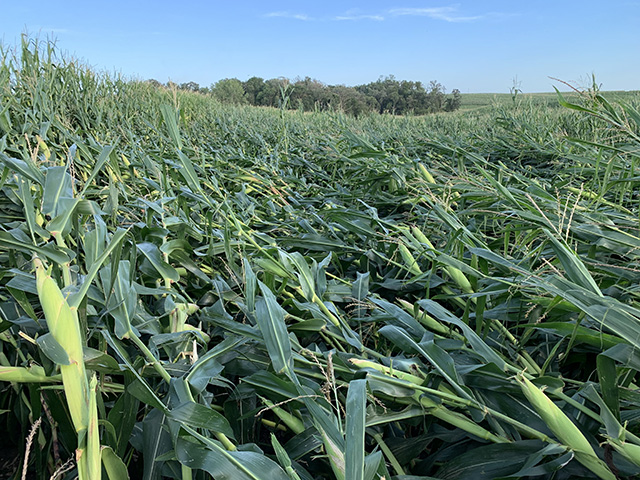USDA on Derecho
Doing the Derecho Dance
One of the biggest wild cards in Friday's USDA reports was their handling of the derecho damage incurred in August. Wind speeds were above 100 mph in some areas and 80 mph-plus over a broad section of Iowa. The winds slowed a little going into Illinois and Indiana.
The storm swept through the Corn Belt after the August crop report data collection had ended, so it was well known that the corrections would have to be made this month. NASS indicated in August they would re-survey producers in the affected areas for their harvested acreage ideas. To complicate things, much of the Corn Belt saw unusually hot and dry conditions in August, with some states posting average temps or low precipitation numbers worse than the 2012 drought for that month (but not for the entire growing season). That was also a drag on yield. Western Iowa and a sliver of eastern Nebraska were in D3 or extreme drought, but all states north of the Ohio River had at least some D0 and D1 dryness.
So, what was the word? Well, it wasn't the final word, as NASS indicated too many producers still hadn't made up their mind or settled with the insurance company. They will re-survey Iowa again for the October crop report to pick up these unresolved fields. Different farms have different combinations of crop revenue insurance, wind and hail, and, of course, varying levels of damage. The rally since the August crop report also makes those bushels in the field more valuable, though prices are still below the spring crop insurance price of $3.88. What "works" for one producer won't necessarily work for the next.
P[L1] D[0x0] M[300x250] OOP[F] ADUNIT[] T[]
In Friday's report, USDA cut projected harvested area for corn by 550,000 acres versus the August crop report. No change was made for soybeans, as those were found to still be in harvestable condition, though perhaps missing a few leaves. Data sources for the report included 9,140 farmer survey responses, 3,930 objective yield plots measured by USDA and data from the MODIS satellite system to fill in the blanks.
The Iowa state average yield was down 5.4% from August on the combination of dryness and derecho damage -- that's 11 bushels per acre (bpa). The average yields were increased for the Dakotas, Minnesota and Wisconsin versus August, but dropped because of the heat and dryness in Nebraska, Kansas, Missouri, Illinois, Indiana, Ohio and Michigan.
As mentioned above, USDA did objective yield plot visits this month after skipping August. Their ears/acre count was higher than 2016, 2017 or 2019 for the 10 tracked states, but well below the averages for 2015 or 2018. National yield is basically ears per acre times grain weight per ear, so higher ear counts bias the numbers toward higher yields and vice versa. The yield cuts dropped the national average yield 1.8% from last month to 178.5 bpa and cut estimated production to 14.900 billion bushels -- that was down 378 million from August, but within 2 million bushels of the average trade guess. That's why we didn't get much price response in corn after the report came out. As a side note, USDA showed zero corn yield loss from Hurricane Laura in Louisiana and Arkansas.
The trade got close to USDA on this one by using some fairly sophisticated data analysis. The wind speed maps were publicly available. Greenness or NDVI differential maps proved to be of limited help because the lodged corn was still green. Some firms overlaid thermal signatures to see where the ground wasn't shaded by the crop, or where fermenting dead corn was heating up. Another data layer involved radar backscatter, with standing corn leaving a different signature than lodged corn.
Where do we go from here?
Let the second guessing begin now, as USDA is going to survey Iowa again for the October crop report. It is not just a question of acreage being zeroed out through insurance claims. The harvest loss is also going to be sizable. Some firms are estimating 80% loss on up to 600,000 acres that are harvested. Others are using 50-80 bpa losses on 2 million to 3 million acres. The NASS objective yield plots will be valuable in this regard, as they go through the plots after harvest and measure everything that was missed or lost when the combine came through.
We also don't want to overlook soybeans. While not significantly impacted by the derecho wind, they were showing some yield losses from the August heat and dryness. The U.S. average yield dropped 1.4 bpa from August. NASS emphasized that frost and freeze damage this week in the Upper Midwest was not factored into the reports on Friday. It occurred after data collection was completed. Further soybean yield losses are anticipated in the October crop report.
Alan Brugler may be contacted at alanb@bruglermktg.com
(c) Copyright 2020 DTN, LLC. All rights reserved.




